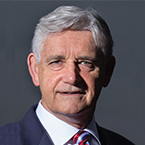
For discovering the human origin recognition complex and pre-replication complex proteins responsible for orchestrating DNA replication, and for further elucidating the mechanisms by which DNA and chromatin are effectively replicated, defining how genetic material is transferred, and how aberrations in replication may contribute to cancer.
Internationally heralded, Dr. Stillman is recognized for his seminal contributions to the understanding of eukaryotic DNA replication, including the discovery of the human origin recognition complex (ORC) and pre-replication complex (pre-RC) proteins responsible for orchestrating replication. His research has explained the mechanisms by which DNA is replicated, demonstrating how genetic material is transferred and how aberrations in this process may contribute to cancer. His research endeavors included studying SV40 viral replication, resulting in fundamental discoveries that culminated in the complete biochemical reconstitution of SV40 DNA replication. This work delineated the factors required at the replication fork, including replication protein A, replication factor C, proliferating cell nuclear antigen and DNA polymerase-δ and a chromatin assembly protein CAF-1, a protein complex required for the assembly of histone tetramers onto replicated DNA molecules.
During cell division, the genome replication process must be tightly regulated to occur only once during cell division. In a landmark publication, Dr. Stillman used yeast as a model system to identify the six subunits of the ORC (ORC1-6) that recognizes the cellular origins of DNA replication in an ATP-dependent manner. Dr. Stillman also contributed to the identification of the pre-replication complex (pre-RC), composed of the ORC, MCM proteins, Cdc6 and Cdt1. In addition, he has elucidated additional roles that ORC proteins play in human cells, including control of centrosome duplication and gene silencing by in cooperation with the Retinoblastoma tumor suppressor protein, highlighting how ORC ensures successful mammalian cell division. More recently, his research group and collaborators contributed to the visualization at atomic resolution of the ORC, Cdc6, Cdt1 and Mcm2-7 proteins bound to DNA by using cryo-electron microscopy. This work has shed light on the impact of human ORC mutations, found in patients with Meier-Gorlin Syndrome, on ATP-dependent activities with consequences that extend to other illnesses including cancer.
Career Highlights
2020 Dr. H. P. Heineken Prize for Biochemistry and Biophysics, The Royal Netherlands Academy of Arts and Sciences, Amsterdam, Netherlands
2019 Gairdner International Award, Gairdner Foundation
2018 Suzhou Science and Technology Cooperation Contribution Award, City of Suzhou, China
2016 Elected Fellow, National Academy of Inventors
2014 Herbert Tabor Research Award, American Society for Biochemistry and Molecular Biology
2013 Elected Member, National Academy of Sciences, Washington, DC
2012 Elected Corresponding Member, Australian Academy of Science
2010 Louisa Gross Horwitz Prize, Columbia University
2008 Elected Fellow, American Academy of Arts and Sciences
2006 Curtin Medal of Excellence in Medical Research, John Curtin School of Medical Research, Australia National University, Canberra, Australia
2005 Elected Fellow, American Association for the Advancement of Science
2004 Alfred P. Sloan, Jr., Prize, General Motors Cancer Research Foundation
2001 Elected Associate Member, European Molecular Biology Organization
2000 Elected Fellow, American Academy of Microbiology
2000 Elected Foreign Associate, National Academy of Sciences, Washington, DC
1994 Julian Wells Medal, Centre for Cancer Biology, Genome Conference, Australia
1993 Elected Fellow, The Royal Society, London, United Kingdom